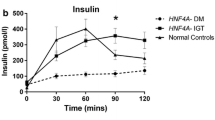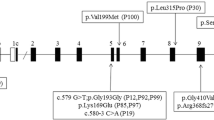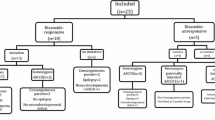Abstract
Introduction
Randomly estimated fasting hyperglycaemia in an asymptomatic individual may represent the first sign of pancreatic β-cell dysfunction.
Objective
We aimed at specifying the genetic aetiology of asymptomatic hyperglycaemia in a cohort of children and adolescents.
Subjects and methods
We analysed the aetiological diagnosis in 82 non-obese paediatric subjects (38 males) aged 0.2-18.5 years (median: 13.1) who were referred for elucidation of a randomly found blood glucose level above 5.5 mmol/l. In addition to fasting glycaemia and circulating levels of insulin and C-peptide, the subjects were tested by an oral glucose tolerance test and an intravenous glucose tolerance test and screened for mutations in the genes encoding glucokinase (GCK), HNF-1α (TCF1), Kir6.2 (KCNJ11) (if aged <2 years) and HNF-4α (HNF4A) (those with a positive family history of diabetes).
Results and discussion
We identified 35 carriers of GCK mutations causing MODY2, two carriers of TCF1 mutations causing MODY3, one carrier of a HNF4A mutation causing MODY1 and one carrier of a KCNJ11 mutation causing permanent neonatal diabetes mellitus. Of the remaining patients, 11 progressed to type 1 diabetes mellitus (T1DM) and 9 had impaired glucose tolerance or diabetes mellitus of unknown origin. In 23 subjects, an impairment of blood glucose levels was not confirmed. We conclude that 39 of 82 paediatric patients (48%) with randomly found fasting hyperglycaemia suffered from single gene defect conditions, MODY2 being the most prevalent. An additional 11 patients (13%) progressed to overt T1DM. The aetiological diagnosis in asymptomatic hyperglycaemic children and adolescents is a clue to introducing an early and effective therapy or, in MODY2, to preventing any future extensive re-investigations.

Similar content being viewed by others
Abbreviations
- FPIR:
-
First-phase insulin release
- GCK:
-
Glucokinase
- GCK :
-
Gene encoding glucokinase
- HbA1C :
-
Glycosylated haemoglobin
- HNF-1α:
-
Hepatocyte nuclear factor-1α
- HNF4A :
-
Gene encoding HNF-4α
- HNF-4α:
-
Hepatocyte nuclear factor-4α
- HNF-1:
-
Hepatocyte nuclear factor-1
- IGT/DM:
-
Impaired glucose tolerance/diabetes mellitus
- IPF-1:
-
insulin promotor factor
- IVGTT:
-
intravenous glucose tolerance test
- KCNJ11 :
-
Gene encoding Kir6.2
- Kir6.2:
-
Inwardly rectifying K+ channel subunit
- MODY:
-
Maturity-onset diabetes of the young
- NGT:
-
Normal glucose tolerance
- OGTT:
-
Oral glucose tolerance test
- PND:
-
Permanent neonatal diabetes mellitus
- SDS:
-
Standard deviation score
- T1DM:
-
Type 1 diabetes mellitus
- TCF1 :
-
Gene encoding HNF-1α
References
American Diabetes Association (2005) Diagnosis and classification of diabetes mellitus. Diabetes Care 28(Suppl 1):S37–S42
Bingley PJ, Colman P, Eisenbarth GS, Jackson RA, McCulloch DK, Riley WJ, Gale EAM (1992) Standardization of IVGTT to predict IDDM. Diabetes Care 15:1313–1316
Blaha P, Vignerova J, Riedlova J, Kobzova J, Krejcovsky L, Brabec M (2005) 6. celostatni antropologicky vyzkum deti a mladeze 2001 Ceska republika. Statni zdravotni ustav, Praha, pp 16–29
Boutin P, Vasseur F, Samson C, Wahl C, Froguel P (2001) Routine mutation screening of HNF-1alpha and CGK genes in MODY diagnosis: how effective are the techniques of DHPLC and direct sequencing used in combination? Diabetologia 44:775–778
Ellard S, Beards F, Allen LIS, Shepherd M, Ballantyne E, Harvey R, Hattersley AT (2000) A high prevalence of glucokinase mutations in gestational diabetic subjects selected by clinical criteria. Diabetologia 43:250–253
Fajans SS, Bell GI, Polonsky KS (2001) Molecular mechanisms and clinical pathophysiology of maturity-onset diabetes of the young. N Engl J Med 345:971–980
Gloyn AL, Pearson ER, Antcliff JF, Proks P, Bruining GJ, Slingerland AS, Howard N, Srinivasan S, Silva JM, Molnes J, Edghill EL, Frayling TM, Temple IK, Mackay D, Shield JP, Sumnik Z, van Rhijn A, Wales JK, Clark P, Gorman S, Aisenberg J, Ellard S, Njolstad PR, Ashcroft FM, Hattersley AT (2004) Activating mutations in the gene encoding the ATP-sensitive potassium-channel subunit Kir6.2 and permanent neonatal diabetes. N Engl J Med 350:1838–1849
Inoue H, Ferrer J, Warren-Perry M, Zhang Y, Millns H, Turner RC, Elbein SC, Hampe CL, Suarez BK, Inagaki N, Seino S, Permutt MA (1997) Sequence variants in the pancreatic islet beta-cell inwardly rectifying K+ channel Kir 6.2 (Bir) gene: identification and lack of role in Caucasian patients with NIDDM. Diabetes 46:502–507
Keskinen P, Korhonen S, Kupila A, Veijola R, Erkkilä S, Savolainen H, Arvilommi P, Simell T, Ilonen J, Knip M, Simell O (2002) First-phase insulin response in young healthy children at genetic and immunological risk for Type I diabetes. Diabetologia 45:1639–1648
Kulmala P, Rahko J, Savola K, Vähäsalo P, Veijola R, Sjöroos M, Reunanen A, Ilonen J, Knip M (2000) Stability of autoantibodies and their relation to genetic and metabolic markers of Type I diabetes in initially unaffected schoolchildren. Diabetologia 43:457–464
Levy-Marchal C, Dubois F, Noël M, Tichet J, Czernichow P (1995) Immunogenetic determinants and prediction of IDDM in French schoolchildren. Diabetes 44:1029–1032
Marquis E, Robert JJ, Bouvattier C, Bellanne-Chantelot C, Junien C, Diatloff-Zito C (2002) Major difference in aetiology and phenotypic abnormalities between transient and permanent neonatal diabetes. J Med Genet 39:370–374
Pearson ER, Velho G, Clark P, Stride A, Shepherd M, Frayling TM, Bulman MP, Ellard S, Froguel P, Hattersley AT (2001) β-cell genes and diabetes: quantitative and qualitative differences in the pathophysiology of hepatic nuclear factor-1α and glucokinase mutations. Diabetes 50:S101–S107
Pontiroli AE (2004) Type 2 diabetes mellitus is becoming the most common type of diabetes in school children. Acta Diabetol 41:85–90
Pruhova S, Ek J, Lebl J, Sumnik Z, Saudek F, Andel M, Pedersen O, Hansen T (2003) Genetic epidemiology of MODY in the Czech republic: new mutations in the MODY genes HNF-4α, GCK and HNF-1α. Diabetologia 46:291–295
Sagen JV, Raeder H, Hathout E, Shehadeh N, Gudmundsson K, Bævre H, Abuelo D, Phornphutkul C, Moines J, Bell GI, Gloyn AL, Hattersley AT, Molven A, Sovik O, Njolstad PR (2004) Permanent neonatal diabetes due to mutations in KCNJ11 encoding Kir6.2: patient characteristics and initial response to sulfonylurea therapy. Diabetes 53:2713–2718
Shield JP (2000) Neonatal diabetes: new insights into aetiology and implications. Horm Res 53(Suppl 1):7–11
Srikanta S, Ganda OP, Gleason RE, Jackson RA, Soeldner JS, Eisenbarth GS (1984) Pre-type I diabetes: linear loss of beta cell response to intravenous glucose. Diabetes 33:717–720
Vavrinec J, Cinek O, Sumnik Z, Kolouskova S, Malcova H, Drevinek P, Snajderova M (2002) Predikce diabetes mellitus 1. typu u ceskych prvostupnovych pribuznych diabetickych pacientu. Vnitrni lekarstvi 48:483–489
Velho G (2003) Le diabète MODY en pratique. Quand y penser? Pourquoi y penser? Ann Endocrinol (Paris) 64(Suppl 1):S17–1S21
Velho G, Robert JJ (2002) Maturity-onset diabetes of the young (MODY): genetic and clinical characteristics. Horm Res 57(Suppl 1):29–33
Winter WE (2003) Newly defined genetic diabetes syndromes: maturity onset diabetes of the young. Rev Endocr Metab Dis 4:43–51
Acknowledgements
The study was supported by a grant of IGA MZ CR No. NB/7420-3 and by a research project of MSM 0021620814. The authors are grateful to all the referring physicians and to the families for an excellent collaboration and to Mrs. Helena Francová for the skilful assistance with metabolic tests.
Author information
Authors and Affiliations
Corresponding author
Rights and permissions
About this article
Cite this article
Feigerlová, E., Pruhová, Š., Dittertová, L. et al. Aetiological heterogeneity of asymptomatic hyperglycaemia in children and adolescents. Eur J Pediatr 165, 446–452 (2006). https://doi.org/10.1007/s00431-006-0106-3
Received:
Revised:
Accepted:
Published:
Issue Date:
DOI: https://doi.org/10.1007/s00431-006-0106-3




